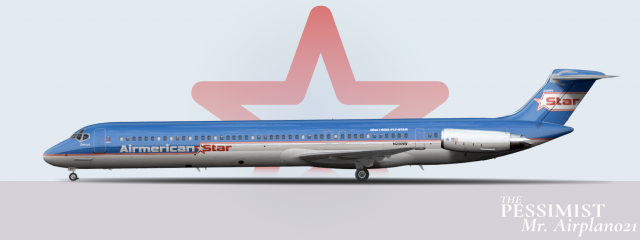
1982 MD-80
- Owner: ThePessimist (View all images and albums)
- Uploaded: Dec 08 2022 06:12 PM
- Views: 724
- Album Star

The launch of Airmerican Star had been successful enough to ensure relative stability for the airline. However, trapped in the confines of the Texas intrastate market, avenues for growth were limited. The tide was turning against the Civil Aeronautics Board and its lethargic, Byzantine fare regulation scheme. In 1978, the Airline Deregulation Act changed this all and removed CAB controls on where airlines flew and how much they charged. As it became clear that the act would pass, Richard Oswalt and his small team began to discuss strategies for growth. For one, they correctly predicted that a deluge of new airlines would enter the market trying to undercut the existing competition. In a post de-regulation era, it wouldn’t be enough for Airmerican Star flights to just be marginally cheaper than competitors. Instead, the airline would invest in its passenger experience – Airmerican Star flights wouldn’t be as outright fancy as the competition but they would be trendy and cool. This involved plans for new crew uniforms and interior designs and a vague understanding that the airline probably needed a real livery. In 1979, the airline expanded to operate many point to point flights out of Little Rock and Reno, both historically seriously underserved by major carriers.
Just as predicted, competition from carriers that seemed to be able to offer impossibly low fares became a major problem for the carrier. Despite its new hubs opening, the airline seemed to be on the brink of stagnation. However, the peaceful death of Dorris Starr at the tender age of 93 provided a substantial cash injection. After her initial cash injection, Dorris had been supportive of the carrier but had remained tight fisted with her money. Through attempting to acquire additional funds, Oswalt had forged a close personal friendship with Starr. In fact, for its first year of operations, the San Antonio branch office of the airline was based in the basement of Dorris’ mansion. Oswalt’s friendship paid dividends when Dorris died because her will left 80% of her wealth to none other than Richard Oswalt. Given that Dorris Starr had been the wealthiest woman in the state of Texas, 80% of her wealth was a considerable sum. Oswalt considered resigning from the board and retreating from managerial hassle, but instead decided that he wanted to funnel most of the money directly into his airline. Perhaps it was to get back at the major carriers with whom he had feuded for so long or perhaps he simply thought he would be bored without his airline project. In 1982, Airmerican Star went on a spending spree that terrified much of the industry. The airline began acquiring new and gently used MD-80 series aircraft. It also introduced a bold new livery that eclipsed the previous bare metal brand identity in a matter of months. New hubs and crew bases popped up in Sacramento, Raleigh, Fort Meyers, and Albany. The expansions brought in huge profits that propelled further spending and growth. By 1987, the blue and red of an Airmerican Star maddog had gone from a regional oddity of the Great Planes and South to a staple of almost any American airport. The airline kept costs low with its hubs in second, or in some cases third, tier cities, but strategically placed these new hubs in relatively close proximity to major cities so that a connecting flight from the hub to nearby major cities was less than an hour. For every year between 1982 and 1985, Airmerican Star had the largest market share growth of any American carrier. This painted a giant target on the airline’s back and with it now posing a legitimate threat to most of America’s major carriers, the boom cycle could and would not last forever.

 Sign In
Sign In Create Account
Create Account













Getting some Valujet vibes from this. Nicely done!